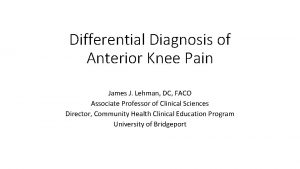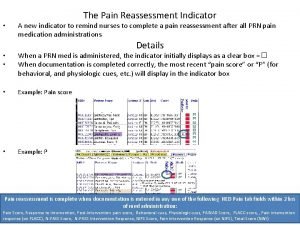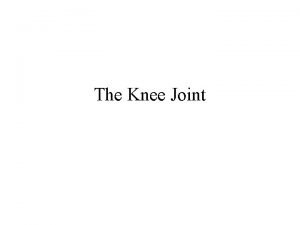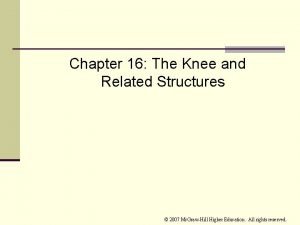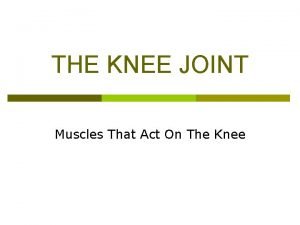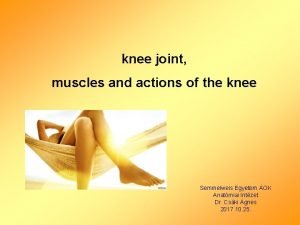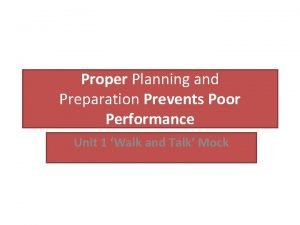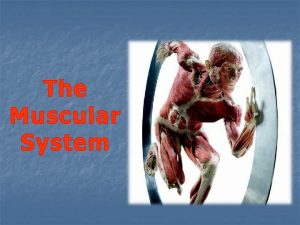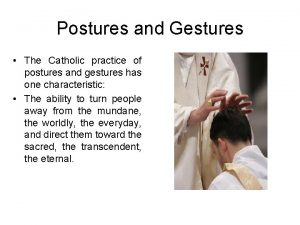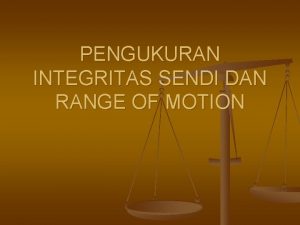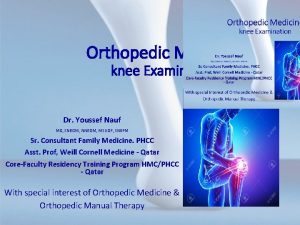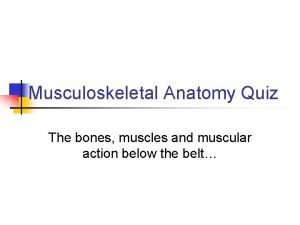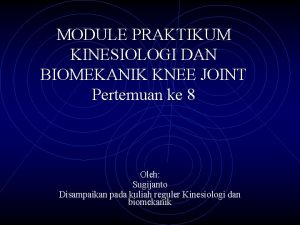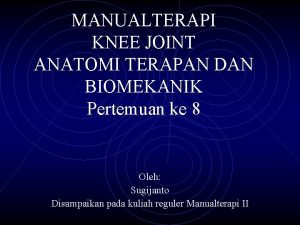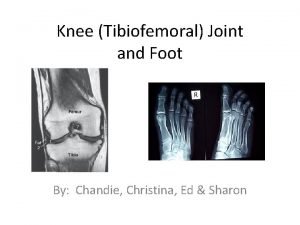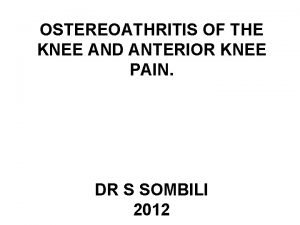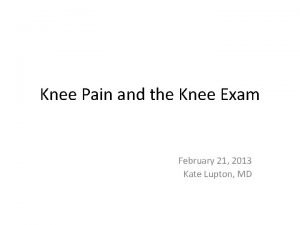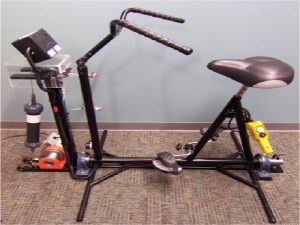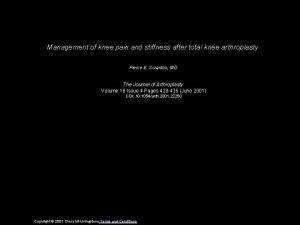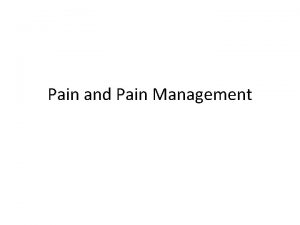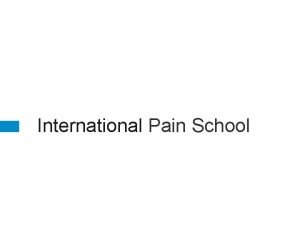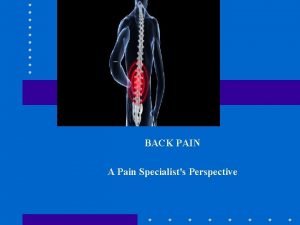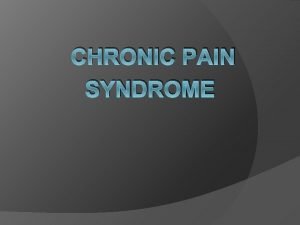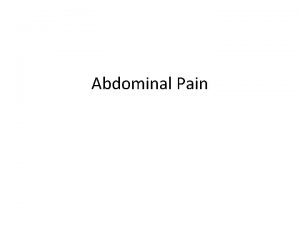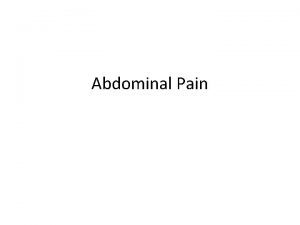Persisting Pain and Poor Function after Knee or


















































- Slides: 50

Persisting Pain and Poor Function after Knee or Hip Joint Arthroplasty: What can learn about this epidemic? Jasvinder Singh, M. B. B. S. , M. P. H. Professor of Medicine, University of Alabama at Birmingham Staff Physician, Birmingham Veterans Affairs Medical Center Director, UAB Gout Clinic Director, UAB Cochrane Network Meta-analysis Satellite Director, Rheumatology Research, Birmingham VA Med Ctr Research Collaborator, Mayo Clinic College of Medicine THE UNIVERSITY OF ALABAMA AT BIRMINGHAM OMICS, June 2016

Disclosures • This project was funded by the orthopedic surgery division funds at the Mayo Clinic and partly by a K-12 training grant (Singh) • Research Funding • • • Patient Centered Outcomes Research Institute (PCORI) NIH: U 10 CA 149950 NIA: R 01 AG 028359, U 01 AG 18947 AHRQ: U 19 HS 021110 VA: Cooperative Studies Program CSP #G 002 Industry: Takeda, Savient • Consultant: Takeda, Savient, Regeneron, Allergan, Iroko, Merz, Bioiberica, Crealta

When do patients get Primary 1 Total Knee Arthroplasty (TKA)? • Moderate to severe pain not adequately relieved by extended course of non-surgical treatment • Clinically significant functional limitation • Radiographic evidence of joint damage • Goal of TKA • Relief of pain and • Improvement in function 1 NIH Consensus Development Conference on Total Knee replacement, December 8 -10, 2003

Projections: primary total hip arthroplasty (THA) and total knee arthroplasty (TKA) procedures in the United States from 2005 to 2030. Kurtz S. et. al. J Bone Joint Surg 2007: 89: 780 -785

Overview • Functional Limitation after TKA • Gender • Age • Body Mass Index • Pain and Function after TKA • Pessimism

Overview • Functional Limitation after TKA • Gender • Age • Body Mass Index • Pain and Function after TKA • Pessimism

Patient factors and Moderate to Severe Functional Limitation Post Total Knee Arthroplasty

Functional Limitation Post TKA: Predictors • Evidence regarding association of Gender, Age and BMI with functional outcomes is contradictory Yes No Gender Fitzgerald 2004; Ritter, Lutgring et al. 2008 Sharma 1996; Hawker 1998; Fortin 1999; Jones 2001; Jones 2003; Lingard 2004; Kennedy 2006 Age Lingard 2004 Hawker 1998; Fortin 1999; Jones 2001; Jones 2003; Fitzgerald 2004 BMI Hawker 1998; Winiarsky 1998; Foran 2004; Lingard 2004; Amin 2006; Krushell 2007; Naylor 2008 Sharma 1996; Jones 2001; Spicer 2001; Jones 2003; Fitzgerald 2004; Amin 2006; Bourne 2007; Nunez 2007; Naal 2008

Study Objective • To examine if Gender, Age and preoperative Body Mass Index (BMI) are significant independent predictors of functional limitation • 2 - and 5 -years after Primary TKA • 2 - and 5 -years after Revision TKA Singh JA et al. Osteoarthritis Cartilage 18(4): 515 -521. Singh JA et al. J Arthroplasty 25(7): 1091 -1095,

Study Design • All primary and revision Total Knee Arthroplasty patients at Mayo Clinic from 1993 -2005 and alive at FU • Patients responded to a mailed questionnaire or completed a questionnaire during clinic visit/telephone at 2 - and 5 years post-TKA • Pain and Function Questionnaire • have construct validity and reproducibility (Mc. Grory 1996), very similar to Knee Society Scale

Study Outcome • Limitation of 3 activities was categorized as follows: • Distance walked • 'Unlimited’ or '> 10 blocks' = None; • '5 -10 blocks ' = Mild; • '< 5 blocks '=Moderate; • 'Housebound', 'Indoors only' or 'Unable' = Severe • Using stairs • Stairs: 'Normal Up and Down’=None; • ‘'Normal Up, Down with Rail' = Mild; • 'Up and Down with Rail' = Moderate; • 'Up with Rail, Down Unable' or 'Unable ' = Severe • Rising from chair • Rise from Chair: 'Able, no arms’ = None; • 'Able, with Arms' = Mild; • 'Able with difficulty' = Moderate; • ' Unable ' = Severe • Moderate-Severe functional limitation: Moderate or Severe limitation ≥ 2 activities

Statistical Analyses • Predictor of Interest: • Gender • Age- ≤ 60, 61 -70, 71 -80, >80 • BMI, categorized per WHO (2000) classification • Normal, <25, overweight, 25 -29. 9, Obese and very obese, 30 -39. 9, extremely obese, ≥ 40 • Confounders: comorbidity (Deyo-Charlson index), ASA class, distance from medical ctr, implant fixation (primary TKA), underlying diagnosis • Multivariable logistic regression models using Generalized Estimating Equations to account for bilaterality • multivariable-adjusted odds ratios with 95% confidence intervals

Gender: We might be a little different

Gender: We might be a little different

RESULTS • Primary TKA- response rate • 65% (7, 139/10, 957) at 2 -year FU • 57% (4, 234/7, 404 ) at 5 -year FU • Revision TKA- response rate • 57% (1, 553/2, 695) at 2 -year FU • 48% (881/1, 842) at 5 -year FU

RESULTS • Clinical Characteristics • Primary TKA • Mean (SD) age, 68 (10) • 56% F • OA- 95% • BMI ≥ 25, 87% • Revision TKA • Mean (SD) age, 69 (10) years • 51% F • Loosening, wear or osteolysis -61% • BMI ≥ 25, 87%


Prevalence: Moderate-Severe Functional Limitation Primary TKA 2 -year Moderate. Severe Functional Limitation 20. 7% Primary TKA 5 -year 27. 2% Revision TKA 2 -year Revision TKA 5 -year 46. 5% 50. 5%

Primary TKA: Moderate-severe functional limitation 2 years

Primary TKA: Moderate-severe functional limitation - 5 years

Revision TKA: Moderate-severe functional limitation - 2 years

Revision TKA: Moderate-severe functional limitation - 5 years

Study Strengths/limitations • Limitations • Non-Response Bias • 57 -65% response rate • 5 -year revision TKAs, 48% • Residual confounding • Did not assess impact of change of BMI post-operatively • Strengths • Large sample size- enough patients in each BMI category • Ability to control for many confounders

Overview • Functional Limitation after TKA • Gender • Age • Body Mass Index • Pain and Function after TKA • Pessimism

Do Psychological Factors Affect Outcomes after Primary TKA? Singh JA et al. J Bone Joint Surg Br 92(6): 799 -806

Pessimistic Explanatory Style • Seligman's theory: “Causal Attribution” • that the manner in which people "explain" (i. e. , cognitively) to themselves, the reasons for the occurrence of specific, important, good or bad events in their lives (e. g. , "Why did this happen to me? ") has important ramifications. • More specifically, according to Seligman's theory, people are described as having a pessimistic attributional style who • 1) attribute the causes of adverse events in their lives to themselves (i. e. , an internal explanation, "It's me. . . "), • 2) carry the expectation that the condition will persist (i. e. , a stable explanation, ". . . happened again, as usual. . . "), and • 3) believe that it will affect other aspects of their life ( a global explanation, ". . . and now. . . I'll never get to. . . " ) can be described.





Study Objective • To examine the impact of pessimistic explanatory style on 2 -and 5 -year outcomes following Total Knee Arthroplasty (TKA)

Study Design • 894 primary TKA surgeries from 1993 -2005 in which the patients responded to Total Joint Registry routine clinical follow-up questionnaires sent to all patients @ 2 and 5 year follow-up. • construct validity and reproducibility (Mc. Grory 1996) • very similar to Knee Society Scale • Scores from the Optimism-Pessimism (PSM) scale from the Minnesota Multiphasic Personality Inventory (MMPI) completed by a subset of TKA patients a median of 16. 1 years before their TKA as a part of clinical care • Obtained for 783 primary TKA surgeries with 2 -year surveys and 443 primary TKA surgeries with 5 -year surveys.

Study Outcome • Outcomes assessed on 2 - and 5 -year clinical questionnaire: • moderate-severe pain (reference- no/mild/walking/ walking and stairs pain) • moderate-severe functional limitation = moderatesevere limitation in ≥ 2 of 3 activities (walking, climbing stairs, chair transfer; reference- no limitation, mild limitation or moderate-severe limitation in 1 activity) • Best change in knee function compared to preoperative rated as much better by patient (reference, somewhat better/same/ worse).

Statistical Analyses • Predictor of Interest: • PSM score as a categorical (score, 0 -100, tscore>60 =pessimist) • Confounders: gender, age, depression, distance from medical center • Multivariable-adjusted logistic regression models, • Odds Ratio (OR) with 95% Confidence Interval (CI) are presented • p<0. 05 was considered significant

Results • Clinical Characteristics • Primary TKA- 2 -year FU • Mean (SD) age, 69 (10); 62% F; • OA- 94% • BMI ≥ 25, 88% • Primary TKA- 5 -year FU • Mean (SD) age, 69 (9) years; 58% F • OA -92% • BMI ≥ 25, 87%

Pessimism and Moderate-Severe Pain post-PRIMARY TKA 2 -yr 5 -yr n/N (%) Odds ratio (95% CI) Pn/N (%) value Odds ratio (95% CI) No 52/533 (9. 8%) 1. 0 34/306 (11. 1%) 1. 0 Yes 35/222 (15. 8%) 2. 21 (1. 12, 4. 35) 18/126 (14. 3%) 1. 21 (0. 51, 2. 83) Pvalue Pessimist 0. 02 0. 67

Pessimism and Best Improvement in Knee Function post-PRIMARY TKA 2 -yr n/N (%) Odds ratio (95% CI) No 457/532 (85. 9%) 1. 0 Yes 173/222 (77. 9%) 0. 53 (0. 30, 0. 96) 5 -yr Pvalue n/N (%) Odds ratio (95% CI) 255/305 (83. 6%) 1. 0 100/123 (81. 3%) 1. 26 (0. 57, 2. 77) Pvalue Pessimist 0. 04 0. 57

Pessimism and Moderate-Severe Functional Limitation post-PRIMARY TKA 2 -yr n/N (%) Odds ratio (95% CI) No 136/523 (26%) 1. 0 Yes 72/220 (32. 7%) 1. 38 (0. 95, 2. 02) 5 -yr Pn/N (%) value Odds ratio (95% CI) Pvalue Pessimist 0. 09 95/298 (31. 9%) 1. 0 53/123 (43. 1%) 1. 84 (0. 98, 3. 43) 0. 06

Study Strengths/limitations • Limitations • Responder Bias • Residual confounding • Sample size small for 5 -year FU • Strengths • Large sample size- enough patients with MMPI scores • Ability to control for important confounders

Conclusions and Implications • Patients with pessimistic style had worse pain and function outcomes at 2 -years after primary TKA • Age, gender and obesity are associated with worse function outcomes at 2 - and 5 -years after primary and revision TKA • Future studies should investigate the reasons for better outcomes after TKA.

Thank you for your attention Comments, Questions….









 After me after me after me
After me after me after me John 14:1-3
John 14:1-3 Differential diagnosis of anterior knee pain
Differential diagnosis of anterior knee pain Mad pain martian pain
Mad pain martian pain Pms vs pregnancy symptoms
Pms vs pregnancy symptoms Knee replacement surgery cost
Knee replacement surgery cost Is pregnancy pain same as period pain
Is pregnancy pain same as period pain Pain reassessment
Pain reassessment A spill at parsenn bowl: knee injury and recovery
A spill at parsenn bowl: knee injury and recovery Muscles that cross hip and knee
Muscles that cross hip and knee Knee anatomy chapter 16 worksheet 1
Knee anatomy chapter 16 worksheet 1 Chapter 16 worksheet the knee and related structures
Chapter 16 worksheet the knee and related structures Gastrocnemius origin and insertion
Gastrocnemius origin and insertion Elbow and knee restraints
Elbow and knee restraints M quadriceps femoris
M quadriceps femoris Locking and unlocking of knee joint
Locking and unlocking of knee joint Mental status examination example
Mental status examination example Explain why some countries are rich while others are poor
Explain why some countries are rich while others are poor Economics for leaders
Economics for leaders Food in tudor times
Food in tudor times Peter singer rich and poor
Peter singer rich and poor Tudor houses rich and poor
Tudor houses rich and poor Samuel de champlain motivation
Samuel de champlain motivation Child for us sinners poor and in the manger
Child for us sinners poor and in the manger песня ivanushka he's poor and young
песня ivanushka he's poor and young Tudor rich and poor
Tudor rich and poor Proper planning and preparation prevents poor performance
Proper planning and preparation prevents poor performance Jerzy grotowski theory
Jerzy grotowski theory Ancient rome recreation
Ancient rome recreation Tudor houses rich and poor
Tudor houses rich and poor Tudor food rich and poor
Tudor food rich and poor Beam knee in ship
Beam knee in ship Hip synovial joint
Hip synovial joint The rhomboid minor muscle sits __________.
The rhomboid minor muscle sits __________. Youtube.com
Youtube.com Palpation
Palpation Vertical fixation suspension
Vertical fixation suspension Wrist rom
Wrist rom Catholic prayer postures
Catholic prayer postures Patient position in nursing
Patient position in nursing Supine horizontal recumbent
Supine horizontal recumbent Knee extension nerve
Knee extension nerve End feel normal
End feel normal Beam knee in ship
Beam knee in ship Knee landmarks
Knee landmarks Styloid process of fibula
Styloid process of fibula Biomekanik knee joint
Biomekanik knee joint Slocum test for knee
Slocum test for knee Anatomi knee joint
Anatomi knee joint Knee walker rental ga
Knee walker rental ga Origin and insertion of hamstrings
Origin and insertion of hamstrings


